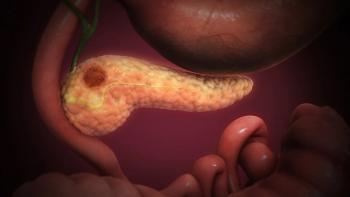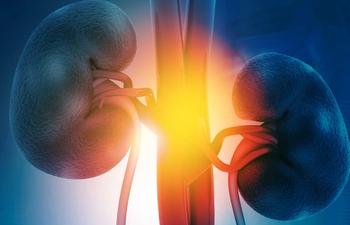
Anlotinib Prolongs EGFR-TKI Clinical Benefit in Advanced NSCLC
Results from a Chinese phase 1 trial reveal that anlotinib plus EGFR-TKIs demonstrated manageable toxicity in NSCLC pre-treated with EGFR-TKIs.
The single-arm phase 2 CTONG-1803/ALTER-LOO1 trial (NCT04007835) evaluating anlotinib (Catequentinib) in combination with EGFR-tyrosine kinase inhibitors (EGFR-TKIs) met its primary end point of progression-free survival (PFS) in patients with advanced non–small cell lung cancer (NSCLC) with gradual, oligo, or potential progression after previous EGFR-TKI treatment, according to findings published in the Journal of Hematology and Oncology.
Data from the trial reveal the median PFS was 9.1 months (95% CI, 6.8-11.7) among all patients evaluable for efficacy (n = 120). Furthermore, the 6- and 12-month PFS rates were 68.5% (95% CI, 58.7%-76.4%) and 38.8% (95% CI, 28.4%-49.0%), respectively. Overall survival (OS) data were immature, with a reported 12-month OS rate of 81.1% (95% CI, 71.8%-87.5%).
“This study suggested the feasibility of the combination of EGFR-TKIs and anlotinib. The strategy not only extends the clinical benefit of original EGFR-TKIs, but also presents an effective, convenient, and well-tolerated option for patients with specific progression modes, such as gradual progression,” Hua-Jun Chen, MD, of the Guangdong Provincial People’s Hospital and lead investigator of the study, wrote with study coinvestigators. “Further research with larger sample sizes and randomized controlled designs may provide additional valuable insights into this treatment approach.”
A total of 140 patients were screened between July 8, 2019, and December 15, 2022, of whom 120 were eligible for inclusion. All patients received at least 1 dose of study treatment, which consisted of 12 mg of oral anlotinib daily for 2 weeks, followed by an off-week period, for 3-week cycles. Treatment continued until disease progression or intolerable toxicities.
Patients in the phase 2 trial were 18 to 75 years of age; had histologically or cytologically confirmed NSCLC; had EGFR–positive disease; received prior EGFR-TKI treatment; and had gradual, oligo, or potential progression. Patients were predominantly women (59.2%), the median age was 57.5 years (range, 29-75 years), and the majority of patients had adenocarcinoma (96.7%).
Overall, 71.7% of patients were previously treated with frontline first- or second-generation EGFR-TKIs, with 26.7% having previous third-generation EGFR-TKI exposure. Additionally, 11.7% of patients had postoperative recurrence at initial EGFR-TKI exposure, and 15.8% of patients received radiotherapy prior to study treatment. Most patients (90.8%) had gradual progression, with 5.0% and 4.2% of patients classified as having oligo or potential progression, respectively.
The primary end point of the study was investigator-assessed PFS. Key secondary end points included 6- and 12-month PFS rates, objective response rate (ORR), disease control rate (DCR), OS, and safety.
Additional efficacy data show that at a median follow-up time of 17.9 months (95% CI, 14.8-19.8), overall DCR was 87.5% (95% CI, 80.2%-92.8%). Furthermore, 63.3% of patients experienced a lesion size reduction from baseline.
The median PFS for patients previously treated with first- or second-generation EGFR-TKIs was 9.2 months (95% CI, 6.7-12.6) vs 10.3 months (95% CI, 6.1-13.3) in those previously treated with third-generation EGFR-TKIs. For patients with brain metastases, the median PFS was 6.8 months (95% CI, 3.5-21.7) vs 9.2 months (95% CI, 6.8-11.7) in those without brain metastases.
Safety data from the trial reveal that the median duration of exposure to anlotinib was 6.1 months (range, 0.0-28.7). Treatment-emergent adverse events (TEAEs) were observed in 96.7% of patients, with 52.5% of patients experiencing grade 3 or higher TEAEs.
TEAEs leading to dose interruption or reduction was experienced by 40.8% of patients, and 12.5% of patients discontinued treatment due to TEAEs. The most common TEAEs were diarrhea (53.3%), hypertension (50.0%), and proteinuria (39.2%).
Reference
Chen HJ, Tu HY, Hu Y, et al. A phase II trial of anlotinib plus EGFR-TKIs in advanced non-small cell lung cancer with gradual, oligo, or potential progression after EGFR-TKIs treatment (CTONG-1803/ALTER-L001). J Hematol Oncol. 2025;18(1):3. doi:10.1186/s13045-024-01656-0
Newsletter
Stay up to date on recent advances in the multidisciplinary approach to cancer.


















































































